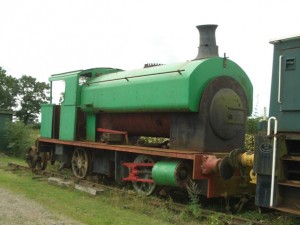Avonside Engine Co., Works Number 1972 built in 1927.
STAMFORD worked at Staveley Minerals Ltd, Pilton Ironstone Quarries, Rutland.
The Staveley Minerals Ltd concerns favoured the six wheel products of the Avonside Engine Company and a number of ex-ironstone examples survive of which STAMFORD is the one with most local relevance to our collection.
Supplied new to Pilton Quarries on 23rd February 1927, the locomotive was specified with an open backed cab to allow escape when working through the narrow three-corner tunnels at Pilton.
The Pilton system had a number of unique features including semaphore signals to protect the steeply graded and curved climb past the loco sheds to the quarries as well as a swinging bar Midland Railway shunting signal near the weighbridge office in the exchange sidings.
In latter years STAMFORD was the loco on duty for a visit of the Industrial Railway Society and recently a number of photographs of this visit in 1966 have been published.
Fifty years of ironstone quarrying at Pilton in rural Rutland finally came to an end on 7th June 1969 when STAMFORD worked its last train load of ironstone. Upon quarry closure the STAMFORD locomotive assisted with track lifting on the quarry railway as required until October of that year when it was secured for preservation and taken to the Bluebell Railway in East Sussex where it was initially dismantled for overhaul but never completed..
In 2010 the locomotive returned to Rutland on loan to the Museum. The Bluebell Railway subsequently agreed to sell this historic locomotive and the museum launched a fund raising campaign. The campaign was successful and ownership of the locomotive passed to the Museum in November 2022 to conserve it as a museum exhibit on public display. STAMFORD is one of only a very few steam locomotives that worked in Rutland’s ironstone quarries to survive into preservation.



